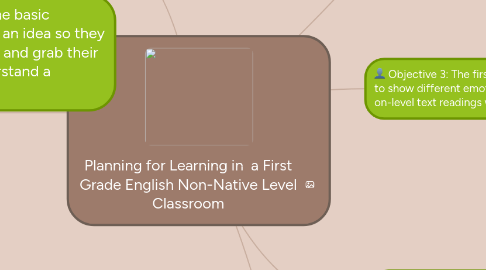
1. Big Ideas: Distinguishing between: rate and accuracy. Establishing how to show different emotions and different tones.
2. Standard: R. F 1.4b Read on-level texts orally with accuracy, rate, and expression.
2.1. By: Candice Clemente
3. Objective 2: The first grade students will be able to read on-level texts at an appropriate rate and accuracy within one month's time.
3.1. Strategy 2: Stories: Relating a story to rate will help students remember how to read with the correct rate
3.1.1. 1. The teacher will read the story "The Tortoise and the Hare" to the students.
3.1.2. 2. As a class they will brainstorm the meaning behind the story. Placing emphasis on not going too fast, or not going too slow.
3.1.3. 3. In groups, the students need to list ideas for times when doing something too fast or too slow is a bad idea. They will share these ideas with the class.
3.1.4. 4. The teacher will then relate this concept to reading too fast and too slow. To make sure the students understand the connection.
3.1.5. 5. The teacher will allow individual students to write in the journals why reading too fast or too slow is a bad idea. If students have trouble with writing, they are allowed to draw pictures of why this is a bad idea.
3.2. Strategy 1: Venn Diagram: Creating a Venn Diagram of rate and accuracy will help the students distinguish between the two ideas.
3.2.1. 1. The teacher will show the class what Venn Diagram is by comparing apples and oranges.
3.2.2. 2. The class will create a Venn Diagram for rate and accuracy.
3.2.3. 3. Some groups will create a Venn Diagram for rate: too slow and too fast. Some groups will create a Venn Diagram for accuracy: sounding out all the words and skipping some words.
3.2.4. 4. Individual students will then explain in a journal entry what is the difference between rate and accuracy to display their knowledge on the two ideas.
4. Key Factors: Allowing those students who struggle with the basic concepts to first see the teacher, class, and group models an idea so they can do it individually. Allows students with ADHD to focus and grab their attention by using collaboration to help them better understand a concept.
5. Objective 3: The first grade students will be able to show different emotions and tones in their on-level text readings within one month's time.
5.1. Strategy: Examples: Mood Sorting will help the students with determining a person's emotions and tones based on their situation.
5.1.1. 1. The teacher will list a variety of moods on the board for everyone to see. Then, they will ask the students to come up with different situations at random and list those on the board as well. For example, a student lost their homework. Next, the teacher will sort some of these situations into the different mood groups. i.e. The student who lost their homework would fall under the scared/nervous/worried mood group.
5.1.2. 2. The class would have a try next and sort out a few of the situations they listed on the board.
5.1.3. 3. The teacher will pass out situations and mood groups handouts to small groups. These groups will work together to sort the situations into the correct moods.
5.1.4. 4. As a homework assignment, individual students will create 3 different mood drawings for 3 situations their teacher assigns them. For example, Jerry is assigned: a teacher whose entire class got 100% on the test; a boy whose bicycle broke; a girl who got moved into a higher level English class.
6. Objective 4: The first grade students will be able to portray different characters by using emotions and tones in their on-level text readings within one month's time.
6.1. Strategy: Cue Cards: Allowing the students to use cue cards for different emotions will allow them to better understand characters of a text.
6.1.1. 1. The teacher will provide different emotion cue cards such as: angry, happy, sad, nervous, excited, and so on. The teacher will play an eReader book on the screen and while it is playing the teacher will show different emotion cue cards based on what the characters are doing and saying.
6.1.2. 2. As a group the students will mimic exactly what the teacher did during the story example. One student will play a story on their iPad, the others will have an emotion cue card. When they think a character is showing their emotion they need to hold up their card.
6.1.3. 3. As a class they will come together for the teacher to read a story on the carpet. Each student will have their own emotion cue card. They will hold up their cue card if a character displays their emotion.
